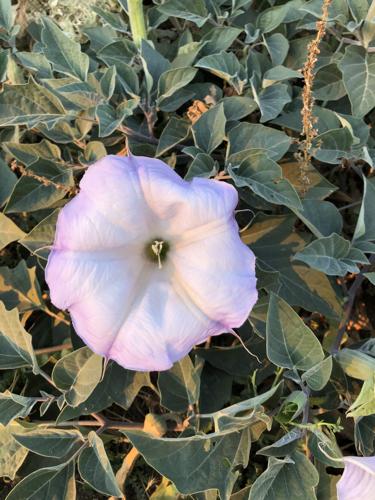I have written before about a common native wildflower known to the Nuwä people as moop, which is pronounced like “mope” and rhymes with “rope.” This widespread plant has also been called moonflower, and its soft beautiful flowers possess a special geometrical beauty at every stage of their lifecycle.
Best known today by the name Datura (Datura wrightti), this robust and exotic-looking plant is also called toloache, especially in Spanish-speaking communities, as well as the names jimsonweed or thornapple.
By whatever name it is known, Datura is a memorable plant. It has dark green leaves and often grows in areas of sandy or disturbed soil, and in neglected areas commonly known by the descriptive if somewhat disparaging term “waste places.”
For this reason, Datura is often assumed to be an introduced weedy plant, since that is often the company that it keeps. It can be found growing among Yellow Starthistle, Cocklebur, Horehound, Star Sticker and other non-natives.
However, Datura is definitely a native that has been in the Tehachapi Mountains for many thousands of years. It is drought-tolerant and able to grow in questionable soils, as well as grow and bloom in late summer and autumn after months of dry weather since the last rain.
Datura is well-known for the hallucinogenic and dangerous alkaloids it contains, which were formerly used by Native peoples to induce visions during initiation rituals.
But I think that the amazing characteristics of the flowers often get overlooked.
To begin with, they open in the late afternoon or evening, which is one of the reasons that they are known as moonflower. The fully mature trumpet-like flower is also pale white, with a large circular appearance that is reminiscent of a full moon.
Initially, however, the flowers do not appear just white — instead, the edges have a lavender tinge to them as though they had been brushed with purple watercolor paint. This delicate hue does not remain, but fades in sunlight to snowy white.
The big flowers, on the day before they open, are not tightly furled but instead are loosely twisted in a symmetrical whorl of five spiraling arms. This unfurls late in the day or after night falls to reveal the large flowers that look like they were made from white flannel fabric.
These big flowers get visited by different species night-flying hawk moths, which hover like hummingbirds in front of the open trumpets and drink in the sweet Datura nectar. The nocturnal flowering of the moop plant, and corresponding nighttime foraging of the hawk moths, means that the moths have first access to the moonflowers without having to compete with daytime insects or actual hummingbirds.
Some sphinx moths lay their eggs on Datura vegetation, and the hornworms that hatch from them emerge and start eating the Datura leaves. These caterpillars resemble the hornworms that are found on tomato and tobacco plants.
After the blossoms complete their short duration of a few days or a week, they eventually shrivel and drop off and in their place a spiny seed structure forms. This is the source of the name thornapple, and like the flowers, it too has a geometrical shape, resembling an inflated puffer fish.
Datura can be found growing throughout the Tehachapi Mountains, and if you encounter them, take a moment to appreciate the artful design of their luxuriant flowers.
Have a good week.
Jon Hammond has written for Tehachapi News for more than 40 years. Send email to tehachapimtnlover@gmail.com.












Commented
Sorry, there are no recent results for popular commented articles.